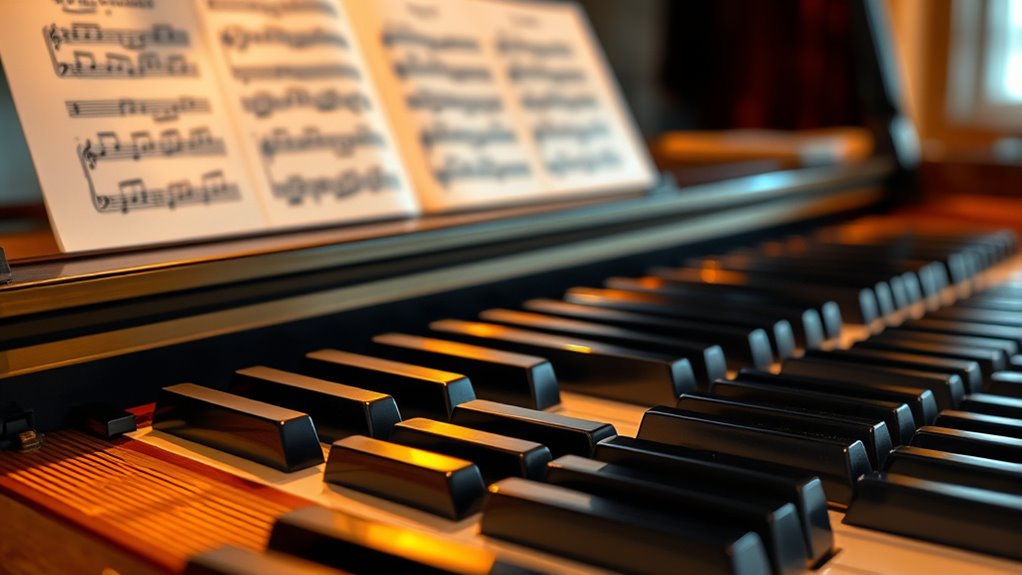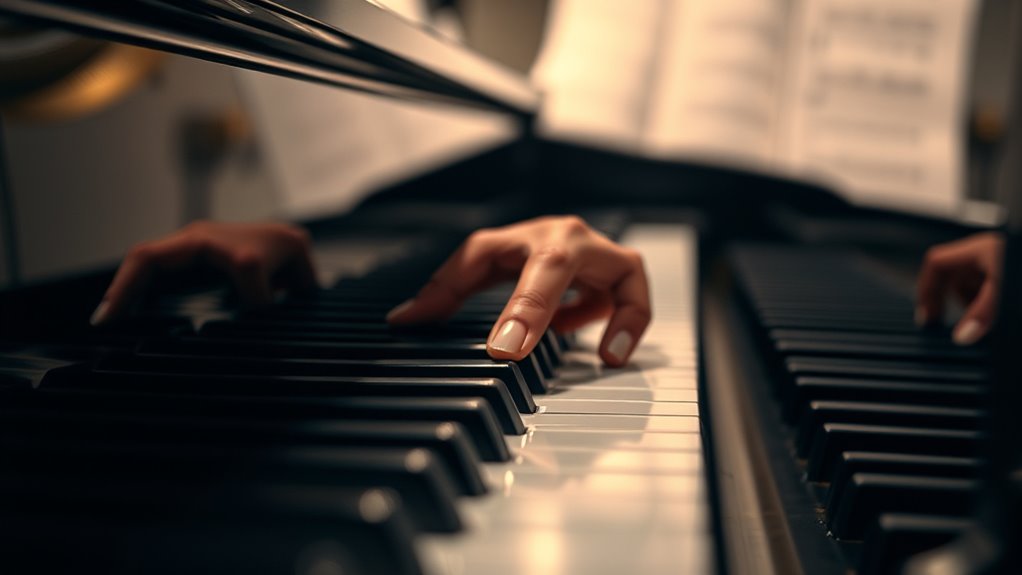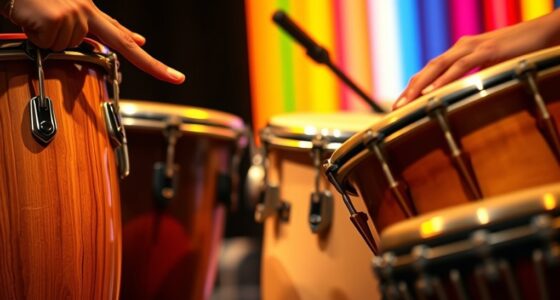Harmonic rhythm is all about where chords change in your music and how that timing shapes the emotional vibe. If you change chords on strong beats, it feels stable and grounded; switching on weaker or off-beats adds surprise or tension. By adjusting the speed and placement of these changes, you control the energy and mood of your piece. Exploring these timing choices allows you to craft more expressive and compelling music beyond just the notes.
Key Takeaways
- Harmonic rhythm determines where chords change within a musical piece, affecting emotional flow and musical tension.
- Changes on strong beats create a stable, grounding effect, while off-beat changes add surprise and complexity.
- Manipulating the timing of chord changes can build anticipation or excitement, shaping listener engagement.
- Precise placement of chord changes influences the music’s energy, mood, and expressive qualities.
- Analyzing harmonic rhythm reveals how composers craft emotional impact through timing and progression.

Have you ever noticed how the timing of chord changes can create a sense of movement and tension in music? That’s the essence of harmonic rhythm. It’s all about how quickly or slowly chords change over time, shaping the emotional flow of a piece. When you pay attention to harmonic rhythm, you realize it’s not just about the notes themselves but also about how they’re arranged rhythmically. The way chords progress in time—your chord progression—directly influences how the music feels. For example, a rapid sequence of changes can generate excitement or urgency, while slower shifts might evoke calm or introspection.
Harmonic rhythm shapes emotional flow through timing and rhythmic arrangement of chord changes.
Chords don’t change in isolation; they’re embedded within rhythm patterns that guide their timing. These rhythm patterns determine when each chord happens, creating a pulse that listeners can latch onto. When you listen to a song, you might notice that certain chord changes happen on strong beats—like the downbeat—giving a feeling of stability. Conversely, changes on weaker beats or off-beats can add surprise or tension. This interplay between rhythm patterns and chord progression shapes the overall harmonic rhythm, making the music more dynamic and engaging.
Understanding how to manipulate harmonic rhythm allows you to craft expressive and compelling music. If you want to build anticipation, you might hold a chord longer before switching to the next, stretching out the rhythm pattern. On the other hand, accelerating the rate of chord changes can heighten excitement or create a sense of chaos. It’s all about timing—deciding when a chord shifts to evoke the desired emotional response. Your choice of rhythm patterns influences this timing, whether you opt for steady, predictable changes or syncopated, unpredictable ones. These choices shape the listener’s experience, guiding their emotional journey through your music.
The key is to be intentional with your timing. Even subtle variations in the harmonic rhythm can make a big difference. For instance, a sudden pause before a chord change can build suspense, while a smooth, continuous progression can keep the momentum flowing effortlessly. Recognizing how different rhythm patterns interact with your chord progression enables you to control the energy and mood of your composition. Mastering harmonic rhythm isn’t just about technical skill; it’s about feeling the pulse of your music and using it to communicate your artistic vision. When you understand where and how chords change, you create a richer, more compelling musical experience that resonates deeply with your audience.
Additionally, awareness of harmonic rhythm can help you analyze and interpret your favorite music more deeply, revealing how composers create emotional impact through timing.
Frequently Asked Questions
How Does Harmonic Rhythm Influence Emotional Expression in Music?
Harmonic rhythm influences your emotional expression by shaping progression dynamics and emotional pacing. When chords change quickly, it creates excitement or tension, while slower changes evoke calm or reflection. You can control the mood by altering how often chords shift, guiding listeners through different emotional states. Understanding this, you can craft music that effectively communicates feelings, making your compositions more engaging and emotionally resonant.
Can Harmonic Rhythm Vary Within a Single Piece?
Yes, harmonic rhythm can vary within a single piece. You’ll notice moments of syncopated timing and rhythmic complexity, where chord changes happen unexpectedly or more rapidly, creating excitement or tension. These variations keep the listener engaged and reflect emotional shifts in the music. By changing the pace of chord changes, you can emphasize certain passages, making the piece feel more dynamic and expressive.
What Techniques Do Composers Use to Manipulate Harmonic Rhythm?
Composers manipulate harmonic rhythm by varying the chord progression and rhythmic pacing. They might speed up chord changes during exciting sections or slow them down to create tension. Using syncopation or delaying chords adds unpredictability, while sudden shifts or sustained chords influence the overall feel. These techniques keep listeners engaged, emphasizing emotional moments and shaping the music’s flow through deliberate control of harmonic rhythm.
How Does Harmonic Rhythm Interact With Melodic Development?
You notice how harmonic rhythm influences melodic phrasing and thematic development, creating tension and release. When chords change swiftly, melodies often become more rhythmic and energetic, emphasizing new themes. Conversely, slower harmonic shifts give space for expressive melodic lines and deeper thematic exploration. This interaction guides your emotional response, shaping the overall narrative of the piece by balancing harmonic movement with melodic development.
Are There Cultural Differences in the Perception of Harmonic Rhythm?
You’ll find that cultural interpretation influences how you perceive harmonic rhythm, shaping your expectations about chord changes. In some cultures, rapid chord shifts may feel exciting, while others prefer slower progressions for emotional impact. Your listener expectations are shaped by your musical background, so what sounds dynamic in one tradition might seem abrupt or too slow in another. Recognizing these differences helps you connect more deeply with diverse audiences.
Conclusion
So, next time you’re composing, remember that timing those chord changes isn’t just a trivial detail—it’s the secret sauce that keeps your listeners awake. Ignore harmonic rhythm at your peril; your song might just meander into musical oblivion. Embrace the art of well-placed chords, or risk becoming the musical equivalent of a yawn-inducing lecture. After all, who knew that when chords change could make or break your masterpiece? Cheers to rhythmic revolution!










